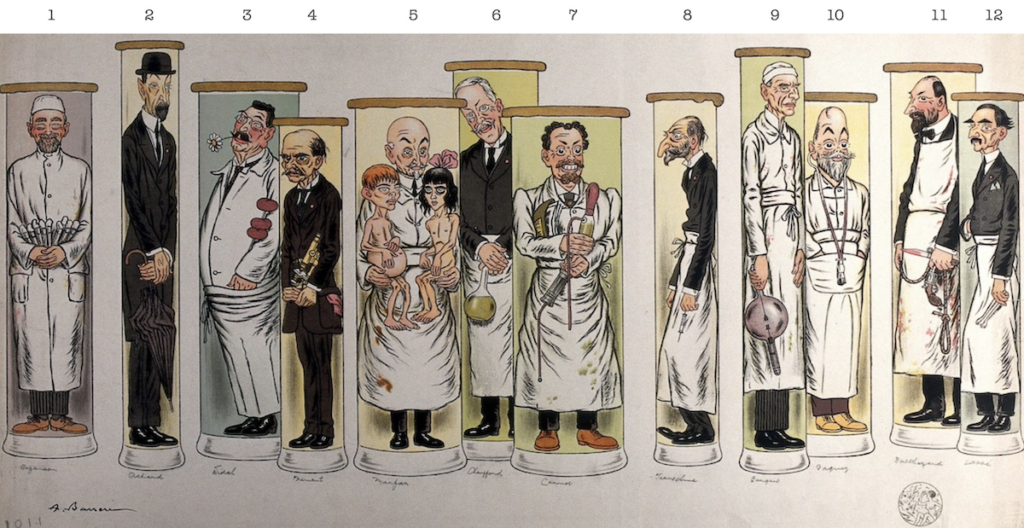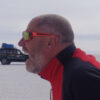Twelve Professors of Pathology
Adrien Barrère (1874-1931) produced a series of lithographs of the Professors in the Faculties of Medicine and the Law, four of the former and two of the latter. Barrère printed the plates himself and sold 420,000 over a period of twenty-five years and provides an informal glimpse into French medicine of the early 20th century.
Information provided on the caricature cast is based on the original work of orthopaedic surgeon Mr David Le Vay MS FRCS and his 1971 publications in The Practitioner
This third medical lithograph is likely to have been produced around 1910. It includes a grouping of twelve French professors, mainly pathologists and bacteriologists, presented as bottled pathological specimens. The vignette in the bottom right-hand corner is of a lady thumbing her nose at some bacteria, which suggests that the bacterial theory of disease was still not firmly rooted in the first decade of the century.
From left to right the personalities depicted are as follows:
(1) Fernand Jules Félicien Bezançon (1868-1948) in white, holding a collection of test-tubes. He was a member of the section of medical pathology of the Academy, and president in 1938. Authored ‘Sang, organes hématopoïétïques, rate, os‘ in 1922 and later Traité d’hématologie with Marcel Labbé (12)
(2) Émile-Charles Achard (I860-1944), carrying an umbrella, was Professor of general pathology and therapeutics at the Hôpital Necker. Achard discovered paratyphoid fever, and his treatment of diabetes mellitus with pancreatic extract foreshadowed the discovery of insulin. Described Achard syndrome in 1902 (characterized by arachnodactyly, brachycephaly, a receding lower jaw and joint laxity in the extremities) as a different entity to Marfan syndrome (1896). With Joseph Castaigne (1871-1951) developed the ‘Achard-Castaigne test‘; using methylene blue dye to analyze the excretory function of the kidneys.

(3) Georges Fernand Isidor Widal (1862-1929), with a flower in his mouth and some spleens (or kidneys) impaled on a fork. Professor of Internal Pathology and then of Clinical Medicine at the Hôpital Cochin and member of the public health section of the Academy from 1906.
Widal is one of the outstanding figures in the evolution of clinical pathology, part clinician and part laboratory worker. One of the first to incorporate bacteriology and immunology into medicine. He was a pupil, first of Pasteur and then of Dieulafoy, of Roux and of Metchnikoff. He was the first member of the Faculty to teach bacteriology.
With Chantemesse, he discovered the dysentery bacillus. He identified the streptococcus as the common cause of erysipelas, septicaemia and puerperal fever. He made the first functional classification of chronic nephritis into the azotaemic variety, with nitrogen retention, to be treated on a low-protein diet, and the chloride-retention type, with oedema, to be managed on a salt-free intake. He also isolated the group of haemolytic anaemias and studied paroxysmal haemoglobinuria and the role of cold agglutinins.
(4) Louis Prenant (1861-1927), seen holding a microscopes, was Professor of Histology and member of the sections of anatomy and physiology of the Academy from 1911. He discovered various cellular elements; researching histophysiology, comparative histology, histochemistry and histophysics. He developed many methods of fixation and stains.
(5) Antoine Bernard-Jean Marfan (1858-1942), holding a boy and girl in his arms, was paediatrician at the Hôpital Necker. This is an example of Barrère’s medical knowledge and artistic accuracy. Marfan first described his syndrome in 1896 including congenital dislocation of the lens, long spindly spidery limbs, laxity of the ligaments and a tendency to arterial medial calcification. We can see, in these children, how Barrère has depicted the glittering eye of the little girl, the attenuated arms and legs, and the lax dangling wrists.
(6) Anatole Marie Émile Chauffard (1855-1932), carrying a flask of green fluid, was Professor of the History of Medicine and Surgery and member of the section of medical pathology. He worked at Hôpital Cochin and Saint-Antoine, where he took up a clinical chair in 1911. He was a member of the Académie de Médecine.
Chauffard introduced the use of emetine, an alkaloid present in ipecacuanha formerly used in the treatment of amoebic infections; and defined the anaphylactic nature of events following rupture of hydatid cysts. He researched liver disease where he contributed descriptive pathology and detailed analysis of pigmentation in hepatic cirrhosis and bronze diabetes (haemachromatosis)
(7) Paul Carnot (1869-1957), grinning, carrying a complicated pump and syringe, professor of therapeutic medicine to the Paris medical faculty and member to the Académie de Médecine. Enthusiast for opotherapy. Carnot coined the term hémopoïétine (hemopoietin) in 1906 to define the humoral factor he believed responsible for regulation of red blood cell production.
(8) Édouard Jeanselme (1858-1935), cadaverous and seen in profile, was a French dermatologist and medical historian, known for his research of syphilis, leprosy and medicine of the Byzantine Empire. Member of the Académie de médecine (section on medical pathology); president of the Société française d’histoire de la médecine; and first president of the ‘Ligue nationale française contre le péril vénérien‘
(9) Émile-Eugène-Joseph Sergent (1867-1943), shown carrying an x-ray tube. Professor of Medicine, president of the l’Académie de médecine and directed l’hôpital Boucicaut à Paris during the Second World War. Wrote on adrenal pathology.

(10) Louis Henri Vaquez (1860-1936), bearded, with a stethoscope, known for his work in the field of haematology and heart disease, was elected to the therapeutics section in 1919. He first described erythrocythaemia, with its cyanosis and splenomegaly, later more fully studied by Osler, hence the eponym of Osler-Vaquez disease.
(11) Victor Balthazard (1872-1950) with pistol, hangman’s rope and bloodstained knife, was a professor in forensic medicine, criminologist and medico-legal expert. Founder of the Institut de médecine légale he developed theories about tool markings, firearm identification and ballistics; devising a series of procedures to match the bullet to the firearm from which it was fired.
(12) Marcel Labbé (1870-1939) carrying tongs and wearing the Légion d’honneur. Known for his work in nutritional disease, especially diabetes mellitus. Professor of clinical medicine at l’Hôpital de la Pitié then l’Hôpital Cochin. Member of l’Académie de médecine, section of medical pathology.
References
Original image
- Barrère A. Twelve doctors standing in test tubes. Colour lithograph, Colour lithograph, from the Open: Wellcome Collection. 1910.
LITFL Lithograph series
- Peschanski N, Cadogan M. A vivid grouping (1903). LITFL
- Peschanski N, Cadogan M. Sixteen French doctors (1906). LITFL
- Peschanski N, Cadogan M. Twelve Professors of Pathology (1910). LITFL
- Peschanski N, Cadogan M. A Cluster of Surgeons (1910). LITFL
Review articles
- Le Vay D. Adrien Barrère. A French medical caricaturist. 2. Practitioner. 1971 Aug;207(238):239-43
- Knisely WH. Adrien Barrère and his caricatures of the medical faculty of the University of Paris: “The Professors” J Child Neurol. 1988 Jan;3(1):52
[cite]
eponymictionary
the names behind the name
Prof. Nicolas Peschanski currently works as a Consultant in Emergency Medicine at the Urgences Adultes-SAMU-35 SMUR, Centre Hospitalier Universitaire de Rennes. Nicolas does research in Emergency Medicine at U1096 INSERM EnVI Normandy University research Unit. He's Associate Prof. teaching Clinical Medicine and Emergency Medicine at Rennes-1 University School of Medicine. Involved in the #FOAMed development, he is a current member of the french Society of Emergency Medicine Guideline Committee.

